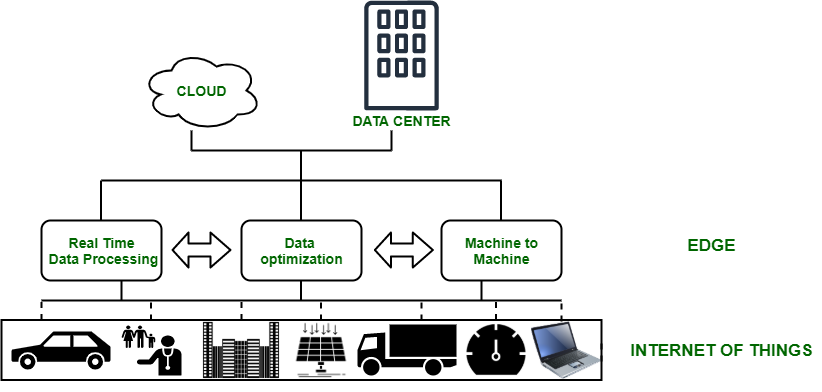Edge Computing – A Building Block for Smart Applications of the Future
Last Updated :
27 Aug, 2020
Faster, smarter, and more efficient networks will be delivered by Edge Computing by processing data and information for more than five billion things or devices right where they are. Digital transformation is made possible by a variety of new technologies, chief among them is Edge Computing. Optimized latency performance of 5G Core processing and 5G NR air interface combined with edge compute can minimize round-trip-time by up to two orders of magnitudes in situations where there is tight control over all parts of the communication chain. Edge Computing will allow operators to deliver services like Augmented Reality/Virtual Reality (AR/VR) and AI. Unlimited revenue opportunities for telecom carriers and remarkable new experiences for users will be created.
The combination of Edge and 5G can deliver reliability, scale, and speed. From smart cities, drones, and autonomous cars for good, to IoT, AR, and innovations in retail and healthcare, we can see the future beginning to unfold. Data privacy and security in Edge is a key consideration. Edge Computing can help to redefine security in the Enterprise by designing security directly into the billions of sensors and devices. A shift from hardware-based networking to Software-Defined Networking (SDN) has permitted operators to migrate faster and create new opportunities that include the integration of both 5G and Edge.
Some examples of Edge Computing are:
- Smart cities
- Financial Sector
- Autonomous vehicles
- Industries
- Retail sectors
- Healthcare during the COVID-19
- Software-Defined Networking and 5G

Why Edge Computing matters?
- Edge enables businesses to manage and analyze more data about their customers and understand their actions and preferences.
- Edge Computing decentralizes data and information which makes any breach difficult to access a complete set of data and information.
- It eliminates the need for data to migrate from the device to the cloud and vice versa.
- It is also useful in providing a lesser latency and decreases the cost of transmission.
- It delivers better performance by minimizing overall traffic loads on the main networks to the cloud.
- Businesses are granted permission to store and categorize data in appropriate locations.
Edge Computing and 5G during COVID-19
In the COVID-19 pandemic, many people are working from their homes. Sharing and transferring large files across wireless networks is maxing out bandwidth capacity in the homes and their neighborhoods. The demand for more access, higher speeds, and better latency has increased and the combination of 5G and Edge brings to bear this combination of features. Wireless capabilities baked into devices means less reliance on bandwidth, and greater speeds and better latency means we can use videos and AR/VR capabilities to be even more productive and advantageous at our homes.
Key Benefits of Edge Computing
- Scalability- Edge computing allows businesses to expand and be agile.
- Reliability- It is able to sustain and deliver support when there is a risk in connectivity.
- Speed- Real-time processing requires speed and response times are available only with Edge Computing.
- Latency- It minimizes latency, resulting in excellent user experiences.
- Security- The processing, storage, and other applications are spread on local data centers neutralizing the disruption of the entire network.
- Cost- Businesses can reduce their operational costs by minimizing the bandwidth needs with Edge Computing.
Challenges of Edge Computing
- Theft of devices and sensors are happening nearly every day in new Edge networks.
- Hackers can access the data and information stored in the devices at their own pace.
- Software updates and security configurations are not present in the devices in an Edge network.
- There is a need to balance more bandwidth across an Edge network.
- Many remote locations lack skilled employees to manage and deploy the Edge framework on a regular basis.
- Businesses are challenged to have optimally categorized data in a distributed computing environment.
- The maintenance of data privacy and security is a crucial challenge for users and businesses.
Edge Security Considerations
- Encrypted tunnels, firewalls, and access control to be used throughout the Edge network.
- Patching cycles and regular updates to be ensured.
- Using AI and Machine Learning to stop hackers.
- To ensure only authorized and authenticated devices can access, transmit, and process data using Encryption Protocols.
- To track and manage the devices.
Like Article
Suggest improvement
Share your thoughts in the comments
Please Login to comment...